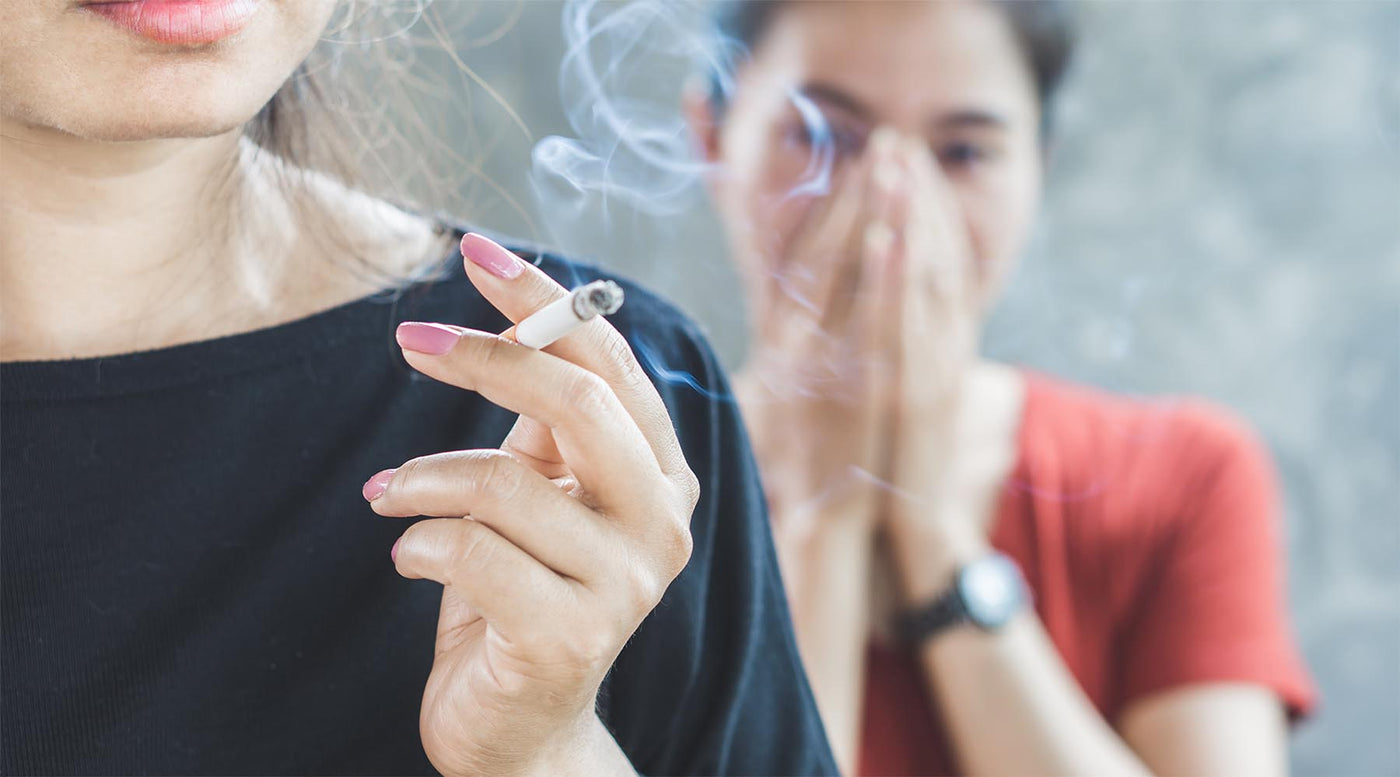
What is passive smoking, and is it really that bad?
Breathing in tobacco smoke from a cigarette you're smoking is really bad for you, but it's a choice you make. However, you don't inhale all the smoke from your cigarettes.
So where does it go?
The answer is simple but brutal; it goes to everyone else as secondhand smoke, and they don't get a choice.
What is passive smoking?
Think of the process of smoking. You inhale, exhale, and the cigarette burns the entire time. That inhale only puts so much smoke into your lungs. Exhaling blows it right back out, and the lit end emits smoke the entire time.
What you inhale is called mainstream smoke. That residual tobacco smoke lingers in the air. It doesn't magically disappear, never to be inhaled again. Instead, it's left to be breathed in by anyone in the area. Non-smokers inhaling tobacco smoke creates passive smoking.
Passive smoking means breathing in tobacco smoke indirectly. That could be from a person currently smoking or burning tobacco products, including cigarettes, cigars, and tobacco pipes, or someone who smoked in an area hours before.
Passive smoke is also known as secondhand smoke exposure, indirect smoke, environmental tobacco smoke, or sidestream smoke.
Chances are, if you're smoking, you're dishing out secondhand smoke. Passive smoking is a significant health risk to children and adults who do not smoke.
Exposure to secondhand smoke
The negative health effects of breathing in someone else's smoke are less concentrated than if you smoke yourself, but the dangers exist all the same, and worse, they're more prevalent in children and unborn babies.
Passive smoking is harmful to one's health, however the negative effects can be minimised by switching to vaping. By creating a smoke-free environment for you and whoever you surround yourself with, you not only improve your health, but theirs as well.
If you're thinking of using a vape to help you on your journey to becoming smoke-free, then make sure to browse our store for the latest and greatest vapes on the market, and get in touch with one of our team for advice on which vape is right for you.
But back to passive smoking.
When does passive smoking happen?
Smoke travels easily, even outdoors. You've probably witnessed someone cough while walking into your cloud of smoke. A person a few meters away might even turn their nose up and walk another direction. That isn't always dramatics. Inhaling passive smoke is as unpleasant as non-smokers make it seem.
If you smoke, passive smoking will happen. An exception would be smoking in an area that no one else has or will ever enter. And that just isn't very likely.
-
If you're smoking in the “smoking area” of a public park, you're still generating secondhand smoke.
-
If you're smoking in the front seat while everyone else is in the back, they're still passive smoking.
-
If you're smoking in your hotel room 2 hours before you check out and the next person checks in, you're still generating secondhand smoke.
Given that the toxins from tobacco smoke linger in an area for up to five hours, there aren't too many scenarios where passive smoking doesn't happen. There will always be some sort of passive smoke exposure to either people currently around you, or people that will soon be in that area.

Law around smoking in public places in the UK
Smoking in enclosed public places and workplaces in the UK has been illegal since 2007. This includes all indoor areas such as restaurants, pubs, and offices, as well as certain outdoor areas such as train stations and bus shelters.
The law, known as the Smoke-free (Premises and Enforcement) Regulations 2006, was introduced to protect people from the harmful effects of second-hand smoke. It is enforced by local authorities and can result in fines for individuals or businesses who fail to comply with the regulations.
In addition, smoking is also prohibited in vehicles with someone under 18 years of age present. This law was introduced in 2015 to protect children from the dangers of second-hand smoke in vehicles.
While the regulations do not ban smoking altogether, they are designed to regulate where smoking is permitted. There are still outdoor areas where smoking is allowed, such as in public parks and on the street, but individuals are encouraged to be considerate of others and avoid smoking in crowded or enclosed areas.
Can passive smoke be limited?
If you watch movies or tv shows from as little as fifteen years ago, you can find footage of people willingly and legally lighting cigarettes indoors. This isn't just part of the drama for the camera; smoking in public spaces was very real. Indoor workplaces, hotels, restaurants, bowling alleys, you name it. All this indoor smoking meant lots of smoke breathed by non smokers.
In many places, regulations to limit or prevent smoking in a public enclosed space are still pretty new. In the UK, for example, smoking indoors publicly was only banned in 2007. Other places such as the US are only a few years ahead, imposing bans around the late 1990's.
This was done to “limit” involuntary smoking. However, all it did was push people to pollute the air outside with secondhand smoke, instead of the air inside.
Indoor or outdoor, air contaminated with secondhand smoke is still unhealthy.
Truth is, the only way to “limit” secondhand smoke is to ditch tobacco products altogether and consume your nicotine in other ways.
What are options for nicotine replacement?
Passive smoke poses health risks just like mainstream smoke does. Making the decision to impact your own health is one you're at full liberty to make. But, where do you draw a line when it comes to imposing those health risks on other people?
If you're open to being considerate enough to switch your tobacco product to something else, you have a few options.
Nicotine can be replaced in the form of vaping, chewing gum, patches, and even mints. All options allow you to still have an oral habit and indulge in nicotine, but without the health risks of smoking traditional cigarettes.
If you enjoy the inhale-exhale motion of smoking, but want a less problematic method, vaping is your best bet. The NHS has even said that vaping is a safer alternative to smoking and a great way to cut down on passive smoke.
Passive vs active smoking
Sadly, the only difference here is the literal action. One person actively inhales the mainstream smoke, accepting risks willingly. The other doesn't, but has no choice in how it impacts their body.
Smokers only get the smoke they inhale. Anyone around them inhales their exhaled smoke and the smoke from the lit end of the cigarette.
Not to mention the makeup of the toxins in the smoke from the lit end of a cigarette is even more potent. None of the toxins have been diluted.
All things considered, passive smoking might be worse.
Is passive smoking as dangerous as smoking?
Whilst it might not be quite as dangerous as actual active smoking, passive smoking is effectively breathing in other people's tobacco smoke, as such, it comes with the same health risks.
In 2004, the International Agency for Research on Cancer declared secondhand smoke as carcinogenic, meaning that if you're exposed to it, you're at a higher risk of developing cancer.
Involuntary exposure to tobacco smoke causes, worsens, or at the very least puts you at an increased risk of getting a whole host of diseases and conditions.
These include lung cancer, cardiovascular diseases such as myocardial infarction (heart attack) and stroke, respiratory problems such as asthma attacks, ear infections, and Sudden Infant Death Syndrome (SIDS).
This is why the UK government decided to ban smoking in buildings and public places, to limit the amount of smoke breathed by non-smokers against their will.
How passive smoke effects non smokers
If learning about what passive smoke is and when it occurs wasn't jarring enough, there's also all the negative health effects it causes.
Looking at the effects of passive smoking on nonsmokers is eye opening. You probably know what it can do to you, but what about others?
Inhalation of indirect smoke can cause the same effects as active smoking. So, yes, the people in your presence while you smoke are also at risk of developing smoking related diseases.
Secondhand smoke produces a specific genetic marker called cotinine. When doctors exam people or autopsy bodies, it's easier to tell if their death or health problems link to passive smoking.
There's no exception on the age or gender of the people affected. From babies in the womb to the elderly, secondhand smoke deteriorates health.
Health risks of passive smoking
Secondhand smokers are at risk for developing the same diseases as direct smokers. Lung cancer, heart disease, plaque build up in blood vessels, asthma and other lung conditions such as COPD have been cited to affect secondhand smokers.
Adults—especially elderly—constantly exposed to other people's smoke also have a greater risk of suffering a heart attack.
Passive smoking and lung function
Passive smoking affects all parts of your body, but none more so than your lungs. The secondhand smoke that you inhale when you are around someone who is smoking causes irritation and inflammation in your airways. Over time, this can lead to chronic obstructive pulmonary disease (often referred to as COPD), which can be life-threatening.
COPD is a progressive disease that makes it difficult for you to breathe. It is caused by long-term exposure to irritants in the air like cigarette smoke, air pollution, or chemicals in certain workplaces like mining or construction sites.
According to the American Lung Association, smoking is the leading cause of preventable death both in the United States and around the world.
To emphasise how damaging it is to breathe in other people's tobacco smoke, we found out it has been estimated that domestic exposure to second-hand smoke in the UK causes around 2,700 deaths in people aged 20-63 and a further 8,000 deaths a year among people aged 65 years and older.
The risk of lung cancer doesn't go away
Lung cancer has been used for years to attempt to scare people away from smoking. And so it should. Recent studies show tobacco smoke induced cancers extend to people that don't smoke directly. Meaning you can still develop lung cancer, even if you've never smoked.
Considering all the other lung conditions that come from exposure to secondhand smoke, this isn't a surprise. It doesn't matter where a nonsmoker is exposed or how. Their risk of lung cancer will increase up to 30%.
Even with modern medicine, the survival rate for one year of lung cancer is only 40%. Human bodies can't discern between an actively or passively ingested chemical. Even without the choice to indulge in cigarettes, fatal health risks happen.
The risk for heart disease increases
Smoke ages the heart, too, not just looks. Coronary heart disease is the second leading cause of death in the UK. Research from the British Heart Foundation shows that heart and circulatory diseases cause an average of 460 deaths each day in the UK. That's more than 160,000 deaths per year - equivalent to one death every three minutes.
The umbrella term 'heart disease' refers to different types of heart issues and the maladies they cause. High blood pressure, cardiac arrest, heart attacks, chronic obstructive pulmonary disease, and arrhythmia all accompany heart disease.
Exposure to tobacco smoke is a main cause for developing heart disease. There used to be an idea that heart issues only affected the elderly. That couldn't be farther from the truth.
In tandem with passive smoke, heart disease has become more common in people less than eighty years old. Passive smoking increases risk for heart disease by 30% after exposure.
Strokes and seizures become more likely
Forms of cancer may take time to onset, however other issues like strokes and seizures can happen immediately. Often, they're just as dangerous.
Cigarette smoke raises heart rate and constricts blood vessels. But, it's impossible to know when someone's body will give an additional response that could be fatal. The chances of these immediate adverse effects are 20-30% more likely to happen after a person has been exposed to tobacco smoke.
The impact of secondhand smoking on mental health and cognitive function
Regularly inhaling second-hand tobacco smoke can have serious long-term effects on mental health and cognitive function. Research has shown that exposure to second-hand smoke is associated with an increased risk of depression, anxiety, and other mental health issues.
In addition, studies have found that passive smoking can have a negative impact on cognitive function. Long-term exposure to second-hand smoke has been linked to poorer memory, attention, and processing speed, which can affect daily life and overall quality of life.
Furthermore, exposure to second-hand smoke during childhood can have even more significant and long-lasting effects on mental health and cognitive function. Children who are exposed to second-hand smoke are at a higher risk of developing behavioural problems, learning difficulties, and mental health issues later in life.
Pregnancy becomes high risk
Society has always had a habit of treating pregnant women like they're fragile. In some ways, they are. Every substance a woman is exposed to during pregnancy affects her unborn baby, too.
Of course pregnant women shouldn't smoke.
What isn't so widely known is that they shouldn't even be exposed to secondhand tobacco smoke.
When a pregnant woman breathes in air polluted with toxins from smoke, those toxins are passed on to the baby. Pregnant women exposed to someone who is actively smoking regularly can subject unborn babies to low birth weight, decreased lung function, higher risk of developing a cleft palate, SIDS, and a weakened cardiovascular system.
If a pregnant woman continually breathes in secondhand smoke during pregnancy, her unborn baby is at a higher risk of being born with a low birth weight or suffering from sudden infant death syndrome, known as cot death. There is also an increased risk of stillbirth or even miscarriages. Frankly, a cigarette isn't worth being responsible for any of these things… even if unintentionally.
Infants and passive smoking
When it comes to newborns, secondhand smoke exposure increases the risk of SIDS. Sudden infant death syndrome (SIDS) is the unexpected death of an infant due to a pause in regulated breathing.
An infant's lungs and immune system can't handle harmful chemicals like nicotine. Infants exposed to tobacco smoke have high concentrations of nicotine in their lungs and raised cotinine levels. The presence of these two chemicals is what causes issues regulating breathing and thus, SIDS.
So, smoking around an infant - even infrequently - can be lethal.
All things considered, it's unfair for unborn babies, newborns, and children to absorb these risks because of the choices of adults around them.
Children exposed to secondhand smoke suffer developmentally
Being a smoker isn't someone's sole occupation. Cigarette smokers are parents, employees, and everything in between. Whether you are a parent or not, the children you expose to tobacco smoke experience side effects. That involuntary exposure puts a damper on many parts of a kid's life.
Kids are in constant development, lungs included. All the toxins in passive smoke are too much for a little set of lungs.

So what happens developmentally to children without a smoke free environment?
Children born into an environment where they're passively inhaling cigarette smoke are also at a heightened risk of developing lung cancer and meningitis.
Kids breathing secondhand smoke can develop asthma, suffer severe asthma attacks, breathing problems, respiratory infections, and ear infections.
Respiratory related issues hinder children and their ability to do simple things like run and play with friends. Considering that's about 50% of a kids life, that's a pretty big problem.
Even worse, witnessing tobacco use at a young age increases the chances of that kid smoking as an adult. They see it as a normal part of life, no different than watching their parents cook or read the news. Without the help of additional education, some may never even know how deadly the habit is.
The effects of secondhand smoke exposure to the elderly
The risks that secondhand smoke exposure causes to humans are also more prevalent in the elderly, as old age and weakened immune systems mean that they are more susceptible to smoking-related diseases.
Owing to their age, older people are more likely to have heart problems, and many will have respiratory issues, so these risks are exacerbated when second-hand smoke is added into the equation.
Additionally, some elderly people may well have a history of smoking or exposure to second-hand smoke, so continuing this behavior in old age is especially dangerous.
Other health problems from passive smoking
Besides the dangers that passive smoking brings in terms of the damage it does to your lung function, heart and blood, it also brings a myriad of other health complications too.
Some of these negative health consequences from breathing in other people's smoke include asthma symptoms, like shortness of breath, ear infections and middle ear disease, though these are some of the lesser of the evils that you might experience.
There are also increased risks of developing other kinds of cancers, like cancer of the blood, throat and mouth.
The health risks that accompany smoking, both actively and passively, are so extensive that whether you're the smoker, or the person living in the vicinity of a smoker, the best option is to get the smoker themselves to quit entirely.
Nicotine addiction from passive smoking
Finally, secondhand smoke contains more than 4,000 harmful chemicals including nicotine, which is the addictive toxin within tobacco products. And did you know - the nicotine in the air can provide a buzz?
Unknown nicotine addictions can stem from repeated exposure. For nonsmokers, this is a nasty experience. If someone isn't a smoker, it won't always click that they could possibly have a nicotine addiction. But if they do, withdrawal symptoms will appear when they aren't around the secondhand smoke. Randomly feeling depressed, trouble sleeping, irritability, and anxiety accompany nicotine withdrawal.
For some, withdrawal symptoms can be severe. Experiencing these things without knowing what's really going on raises alarms. Seeking treatment would be beneficial, but, how do you treat an addiction you aren't aware of?
What can happen if someone is aware of their nicotine addiction?
Say you smoke around your spouse and they are aware of their fixation to nicotine. They can tell they feel different when they aren't around your secondhand smoke. That addiction has already been developed and pinpointed. Making it more likely for them to pick up the smokes to ease the discomfort of withdrawal. Turning a non-smoker into a smoker is one of the most devastating effects of passive smoke.
You have the facts, now what?
Has this made you want to ditch the cigarettes? Hopefully you're itching to make a change in your smoking habit and enjoy the benefits of quitting. And rightly so.
Your enjoyment of cigarettes just doesn't outweigh all the risks they pose to other people—and to yourself!
The age restrictions that apply to cigarettes don't apply to secondhand smoke, so even the youngest people are at risk.
Every inhale pushes someone to nasty implications they didn't sign up for.
Good news is, you aren't powerless. Nip the shortened lifespans and wasted money in the bud. Quit smoking and switch to a tobacco replacement method like vaping.
How to quit smoking
Smoking is the leading cause of preventable disease and death in the UK. It's estimated that smoking causes one in two deaths from cancer in men and one in five deaths from cancer in women.
It causes around 78,000 deaths a year in the UK alone, with a much higher number developing seriously debilitating health conditions as a result.
If you smoke, quitting could save your life. There are many ways to help you quit smoking, including nicotine replacement therapies (NRTs), medications and counselling.
If you're thinking about trying to quit smoking, there are some things you should know before you do:
Quitting smoking is hard - it takes time and effort. But with support, it can be easier than you think, and there are free NHS services set up specifically to help people quit.
You may need more than one attempt to quit for good; don't give up if things get tough or if you fall off the wagon at first - keep going until you stop for good!
You won't be able to completely avoid triggers that make you want to smoke - but learning how to manage them will help keep them at bay when they do happen so that they don't sabotage your quit attempt by making you vulnerable.
Vaping is a safer alternative to passive smoking
Vaping has been touted as a safer alternative to smoking, but is this really true? Here's what you need to know about the effects of second-hand vapour.
Vaping is the use of electronic cigarettes or similar devices to inhale nicotine vapour or aerosol. These are sometimes called e-cigarettes, e-cigs or vaporizers. E-cigarettes don’t contain tobacco, but some e-liquids do contain nicotine derived from tobacco leaves.
Although vaping often involves inhaling nicotine vapour into your lungs, it doesn’t involve burning tobacco leaves or producing secondhand smoke that contains many of the toxins found in cigarette smoke.
Vaping heats up or evaporates liquid, rather than combusting solids through the burning of a lit cigarette, which causes a lot of harmful chemicals. Vaping also doesn’t produce carbon monoxide like cigarettes do, nor the other 4,000 toxins that a lit cigarette gives off.
Passive vaping is essentially breathing in secondhand vapour exhaled from someone vaping - a technique that involves inhaling the vapour from an electronic cigarette (e-cigarette). It has been recommended as a method to quit smoking by the NHS, but it has not been thoroughly studied in the long term due to them being a relatively new invention.
The most common substances found in e-cigarettes are propylene glycol and vegetable glycerin. These substances are also used in many other products such as food, cosmetics and toothpaste.
Using vapes to stop smoking
Thousands of people in the UK have already stopped smoking with the help of an e-cigarette. Studies show that these devices can be effective for quitting.
A study published in 2021 showed that people who used e-cigarettes as a nicotine replacement tool in combination with support groups were up to twice as likely to quit smoking, compared to those who used alternatives like nicotine patches or gum.
E-cigarettes are a popular nicotine replacement tool. To get the most out of yours, make sure you're using it with the right strength of nicotine in your e-liquid.
It can be really helpful to begin your journey into vaping with a starter kit, which provides you with everything you need to get started and keep you going for the first couple of months.
To begin reversing the damage caused by smoking, you need to stop smoking cigarettes completely, and tapering down your use by substituting vapes can help you to do this.




